Artisan Andy Yeo's quest to preserve religious effigies
Andy Yeo has nursed a lifelong love for restoring religious effigies. Today, he hopes to breathe new life into this traditional craft.
- 26 Feb 2024
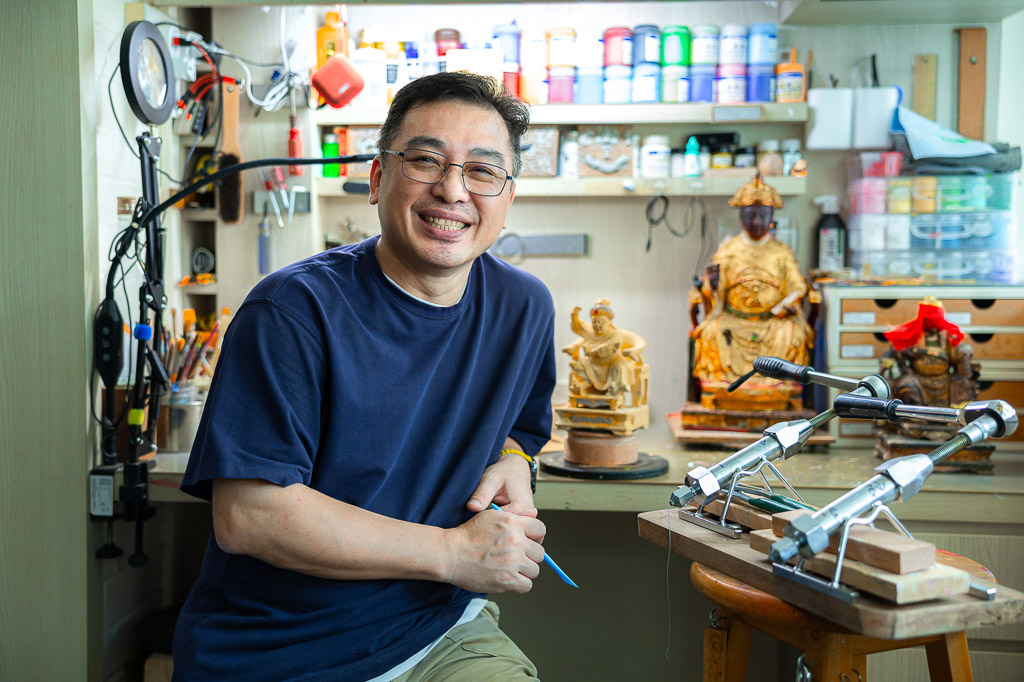
Andy Yeo is a passionate champion of Chinese traditional culture and craft.
Growing up in the busy Chinatown area, young Andy Yeo spent most of his childhood surrounded by temples and Buddhist halls.
After school, he would look forward to meet his friends at the temple three units away from his home. It was here when he encountered effigies, door gods, lion dance heads, and vibrant wall paintings up close. Seeing the vivid expressions of the effigies stirred a sense of fascination in the young boy.
Over the years, Andy noticed that the once new religious effigies were beginning to fall into disrepair. He wondered: could these effigies be fixed?
Little did he know that these childhood encounters would spark his lifelong love for traditional craft restoration.
After school, he would look forward to meet his friends at the temple three units away from his home. It was here when he encountered effigies, door gods, lion dance heads, and vibrant wall paintings up close. Seeing the vivid expressions of the effigies stirred a sense of fascination in the young boy.
Over the years, Andy noticed that the once new religious effigies were beginning to fall into disrepair. He wondered: could these effigies be fixed?
Little did he know that these childhood encounters would spark his lifelong love for traditional craft restoration.
Learning the craft
Back then, there were several crafts shops located along Club Street. Although Andy approached them to pick up the craft, the local craftsmen deeply entrenched in their familial traditions were unwilling to teach outsiders like him. He turned to his next best alternative – books.
It took nearly a decade for him to finally pursue his passion.
When he was 24 years old, Andy was posted to Tainan, Taiwan for work in 2002. As fate would have had it, his accommodation was right next to a temple. He would walk past many master craftsmen carving effigies Every day after work, Andy would hang around the area, finding every chance to befriend the craftsmen and pick up tips from them.
Returning back to Singapore, Andy continued to search up for more information via videos after buying some materials and pigments to work with.
It took nearly a decade for him to finally pursue his passion.
When he was 24 years old, Andy was posted to Tainan, Taiwan for work in 2002. As fate would have had it, his accommodation was right next to a temple. He would walk past many master craftsmen carving effigies Every day after work, Andy would hang around the area, finding every chance to befriend the craftsmen and pick up tips from them.
Returning back to Singapore, Andy continued to search up for more information via videos after buying some materials and pigments to work with.
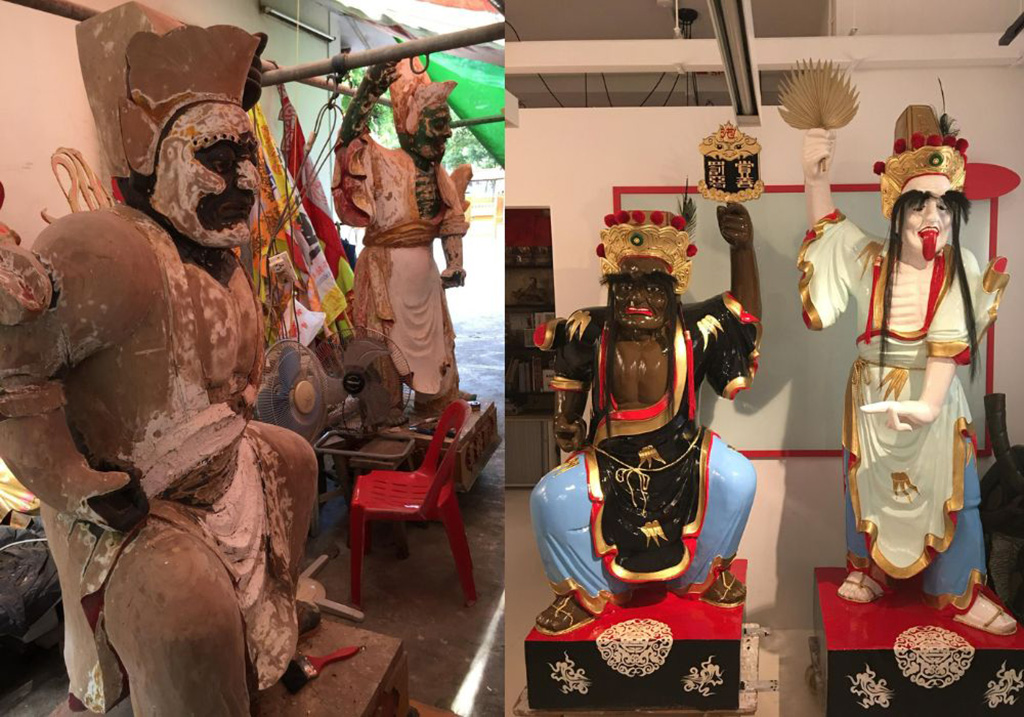
It took Andy 18 months to restore the two six-feet-tall effigies at Poh Chung Tian Chor Sian Tong. They are pictured middle of restoration (left) and after restoration (right). Image credit: Andy Yeo
In 2017, two six-feet-tall effigies at Poh Chung Tian Chor Sian Tong became heavily infested with termites. Andy seized his chance and boldly volunteered to take on the challenge of repairing them.
Andy pitched a small tent behind the temple and worked on the effigies every weekend. It took one and a half years for him to successfully restore them.
Subsequently, Andy began accepting small projects to work on from various temples and associations. He slowly became more adept with the different skills involved, from carving, sculpting, and calligraphy to lantern painting.
Andy pitched a small tent behind the temple and worked on the effigies every weekend. It took one and a half years for him to successfully restore them.
Subsequently, Andy began accepting small projects to work on from various temples and associations. He slowly became more adept with the different skills involved, from carving, sculpting, and calligraphy to lantern painting.
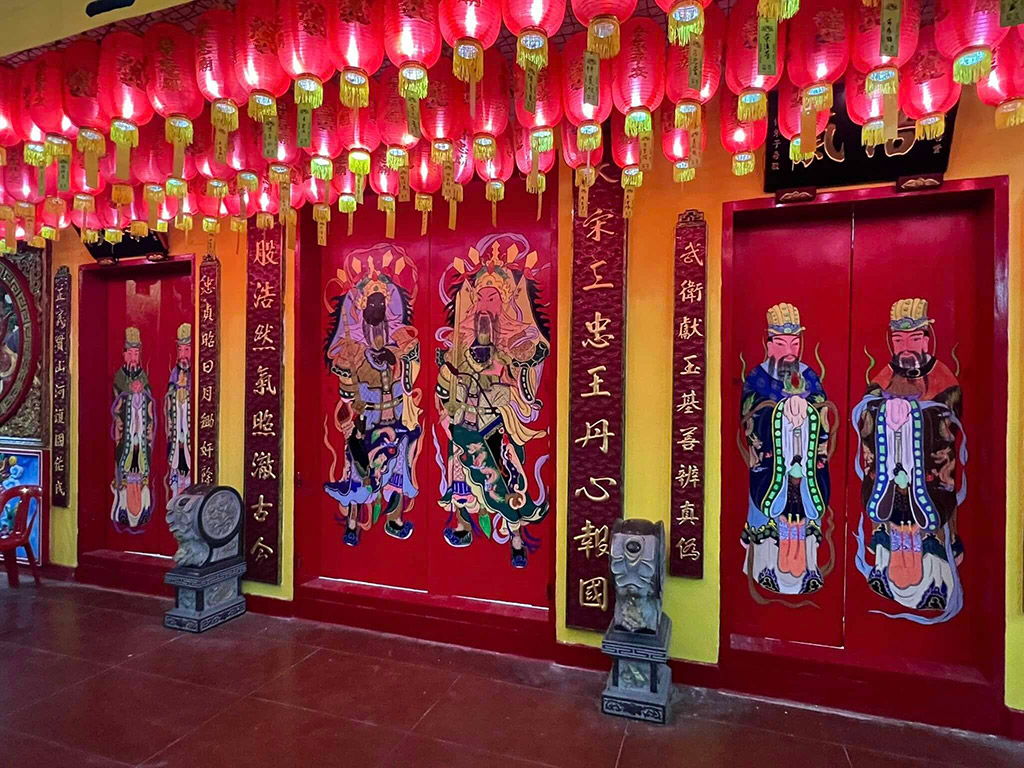
It's a labour of love for Andy, who painstakingly restored these century-old door gods. Image credit: Andy Yeo
He restored century-old door gods, effigies, temple doors, gold furnaces, incense burners, sedan chairs for the deities as well as mural arts in various temples.
In 2015, Andy switched careers from his interior design job to pursue restoration full-time.
But Andy soon found himself limited by his tools and skills. For instance, the knife was not versatile enough to sculpture a dragon effigy. To make it truly come alive and appear more three-dimensional, he needed to master the traditional skill of lacquer threading (qi xian diao) to create decorative patterns. But there were no masters he could learn from in Singapore.
In 2015, Andy switched careers from his interior design job to pursue restoration full-time.
But Andy soon found himself limited by his tools and skills. For instance, the knife was not versatile enough to sculpture a dragon effigy. To make it truly come alive and appear more three-dimensional, he needed to master the traditional skill of lacquer threading (qi xian diao) to create decorative patterns. But there were no masters he could learn from in Singapore.
Taking the skill to the next level
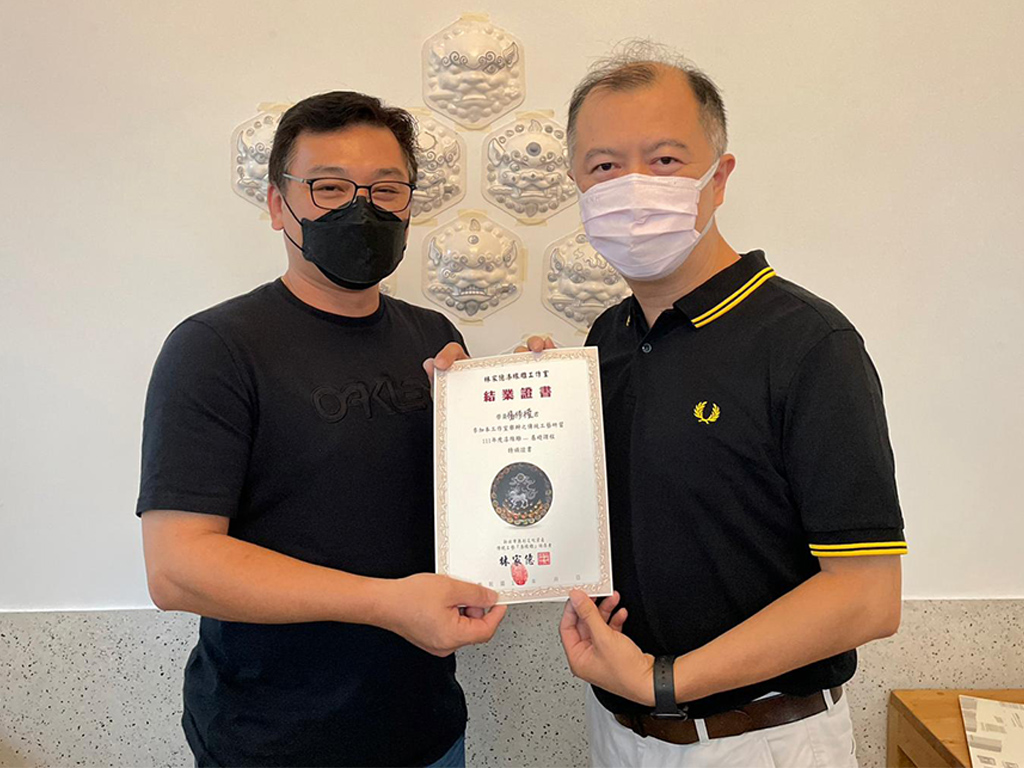
Andy successfully completes a lacquer threading course in Taiwan, and receives a certificate from his master (right). Image credit: Andy Yeo
In December 2022, Andy flew to Kaoshiung, Taiwan to attend a three day course where he picked up lacquer threading. He was the only Singaporean participant.
To continue practising the craft back home, Andy stocked up on a set of machines and supplies that he could not find in Singapore and continued to refine his skills.
To continue practising the craft back home, Andy stocked up on a set of machines and supplies that he could not find in Singapore and continued to refine his skills.
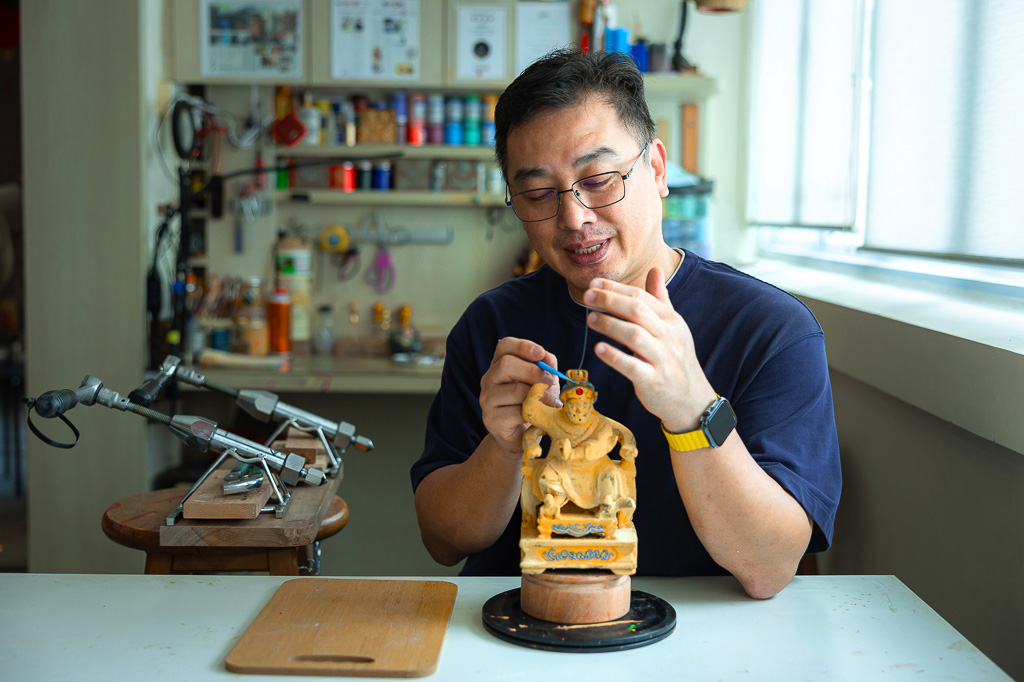
Not many people know about the intensive process that goes into thread sculpting.
Using his newfound skills, Andy was able to do a full restoration of his grandfather’s Monkey God heirloom back to its original state. For Andy, that was an emotional moment.
“I felt like crying…. I was held back previously, but now with this new skill I can complete the whole process from start to end,” he says.
“I felt like crying…. I was held back previously, but now with this new skill I can complete the whole process from start to end,” he says.
What makes a master craftsman
Restoring these effigies is a craft that demands precision, an eye for detail and patience.
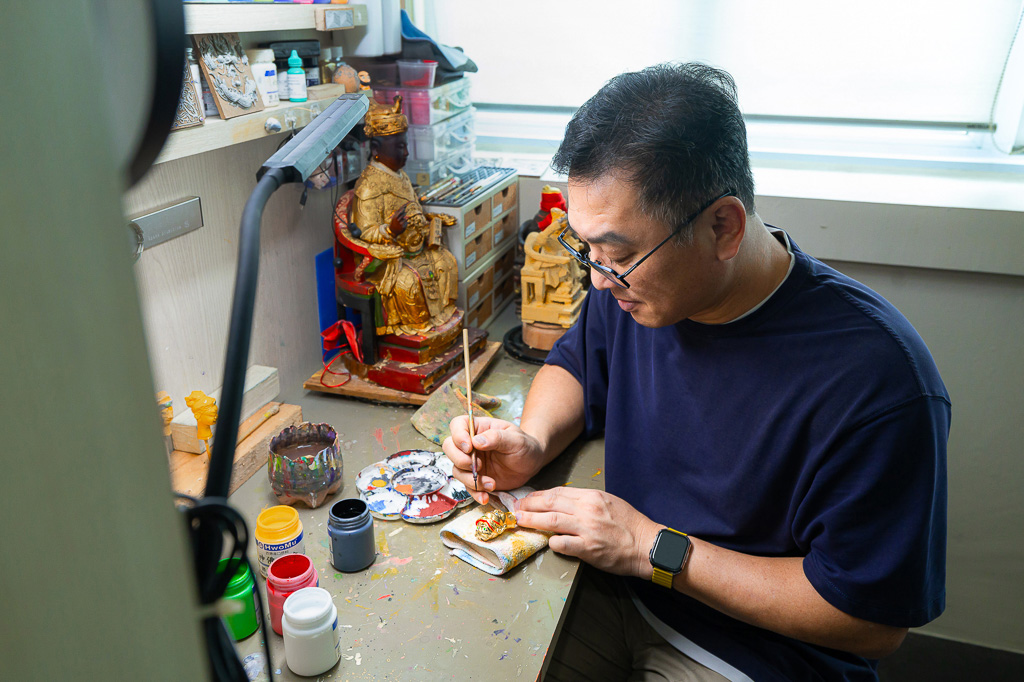
Andy spends a lot of time in his home studio working on the effigies.
To complete an effigy, it can take anywhere between one to three months, depending on the complexity of the project and damage incurred. Most of his work gets done in Andy’s home studio.
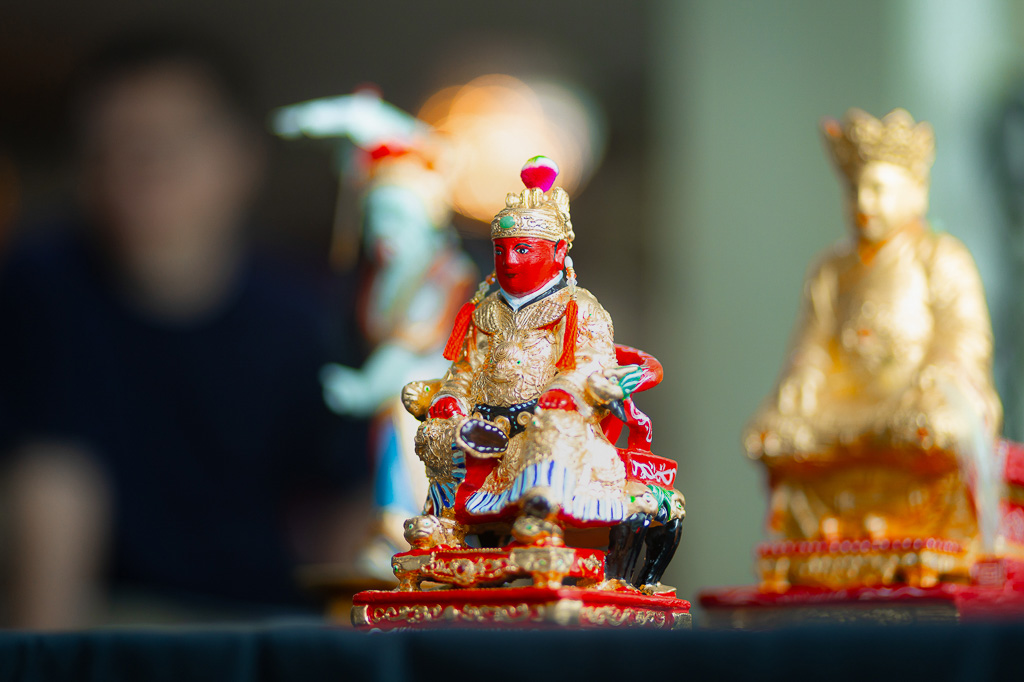
Plenty of research and creative flair is needed for Andy to bring this intricate figurine to life.
It can also get taxing on Andy’s eyes, when he works with figurines as small as 6.5 inches or when he needs to paint tiny details like the deity’s fingernails. At any one time, Andy could be straddling three to four effigy projects.
Unlike some stores which use machines, spray paint and shiny colours to create an eye-catching look, Andy feels religious figurines should look more dignified. When he refurbishes an effigy, his aim is to make it as similar to the original as possible. He draws ideas from various places, be it the Internet, and even visual elements of Chinese opera.
After each restoration, he documents the restoration details in Chinese on the back of the effigy.
Unlike some stores which use machines, spray paint and shiny colours to create an eye-catching look, Andy feels religious figurines should look more dignified. When he refurbishes an effigy, his aim is to make it as similar to the original as possible. He draws ideas from various places, be it the Internet, and even visual elements of Chinese opera.
After each restoration, he documents the restoration details in Chinese on the back of the effigy.
What I love most about my work is when someone is happy with the result and I am able to preserve Chinese culture.
On a mission to modernise and educate
With traditional crafts on a decline and only a handful of masters left, Andy feels saddled with a huge responsibility on his shoulders to transmit this Chinese culture.
The restoration tradition set by our forefathers is an invaluable skill that must be preserved, Andy firmly believes.
Today, the 50-year-old is focused on his next mission: to adapt and integrate modern elements, so as to take the traditional craftsmanship to the next level.
“With very traditional craft, there’s a period where it transits from traditional to modern, and the cycle begins again. Why are we turning to people overseas when we have so much history? People aren’t confident, but give us some time, and we can do it,” he said.
The restoration tradition set by our forefathers is an invaluable skill that must be preserved, Andy firmly believes.
Today, the 50-year-old is focused on his next mission: to adapt and integrate modern elements, so as to take the traditional craftsmanship to the next level.
“With very traditional craft, there’s a period where it transits from traditional to modern, and the cycle begins again. Why are we turning to people overseas when we have so much history? People aren’t confident, but give us some time, and we can do it,” he said.



